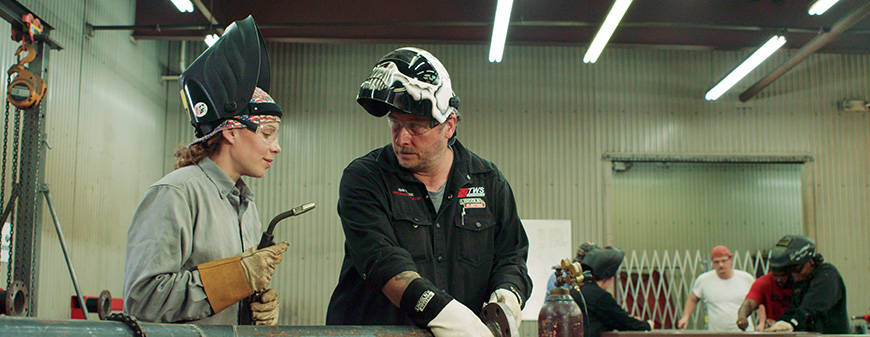TWS is a Great Training Option for Everyone
Learn more about how we can prepare you to advance your career.
What do electrical, welding and HVAC careers all have in common?
- Healthy job growth and wages[1][2][3]
- Active work[4]
- Require more than a high school diploma but less than a 4-year degree.[5][6][7]
- Fields experiencing a skilled labor shortage[8]
Notice the opportunity in the similarities between these three careers? You’re not alone. And what could be a huge chance for millions of American workers to move up the career ladder is becoming a big problem for companies. So big, it even has a name: the “middle-skills gap.”[9]
What exactly are middle-skills jobs, why aren’t there enough workers to fill them, and how can technical training provide solutions to companies and career opportunities to individuals like you? Read on to find out.
What Are Middle-Skills Jobs?
Middle-skills jobs are positions that require some education or training after high school but not a bachelor’s degree.[10]
Have You Considered a Career in the Skilled Trades?
Fill out the form to recieve a no obligation info packet.
Examples of Middle-Skills Jobs
- Heating and air conditioning mechanics and installers
- Welders, cutters and welder fitters
- Electricians
- Electro-mechanical technicians
- Pipefitters and steamfitters
- Solar energy installation managers
- Wind turbine service technicians
- Structural metal fabricators and fitters
- Refrigeration mechanics and installers[11]
Pay and Demand for Middle-Skills Jobs
Middle-Skills Pay
There’s a lot to like about middle-skills jobs. A recent report by the Georgetown University Center on Education and the Workforce found that middle-skills jobs accounted for all of the growth in new good jobs that don’t require a bachelor’s degree.
The organization defines “good jobs” as those paying at least $35,000 and an average of $56,000 for workers with training but not a 4-year degree.[12]
Middle-Skills Demand
- 53 percent of all jobs in the U.S. were middle-skills in 2015.
- 48 percent of all job openings through 2024 will be middle-skills.
- Only 43 percent of America’s workers are trained for middle-skills jobs.[13]
Why Is There a Middle-Skills Gap?
As the statistics above indicate, there are more middle-skills jobs than workers who are qualified to fill them. But why?
The middle-skills gap is largely an issue of diminishing numbers of qualified workers while the demand for them rises. Baby boomers hold many of the vocational positions in the country. Nearly 45 percent of electrical and electronic repairers, electricians, machinery maintenance workers and similar skilled trades positions are held by individuals aged 45 or older.
In the coming years, these workers will likely retire, and not enough younger men and women are replacing them.[14]

New: Industrial Maintenance
Learn About Our New Advanced Industrial Maintenance Program in Houston
Tulsa Welding School is proud to announce our newest program offering available at our Houston Campus – Advanced Industrial Maintenance Technology! Learn the skills you need to take on the industries of manufacturing, distribution, energy production and facility maintenance in as few as 7 months.
One reason for this is that many high school students have been on the university track in recent years. Despite the rising cost and diminishing returns on a bachelor’s degree, the perception that four years of college is the path to “high-paying professional success seems unlikely to diminish in the foreseeable future.”[15]
How Can Technical Training Prepare Workers for Middle-Skills Jobs?
“A growing array of approaches has evolved to prepare students for middle-skills jobs, including apprenticeships, on-the-job training, college career and technical education, customized training, non-credit education, certificates, certifications and associate degrees.” -Georgetown University Center on Education and the Workforce.[16]
Technical training, also known as vocational training, is a form of hands-on instruction that prepares a student for a specific career.[17] For example, welding training at a trade school provides instruction in fundamental welding processes that can be used in a variety of industries.
Unlike a university or even community college, students only learn the skills they need for the job. No general education courses like English are required.
Workers can prepare for many middle-skills jobs through vocational training or apprenticeships.[18] Which path they choose depends on the specific requirements of the job.
Time and resources are other considerations. Trade school programs can be two years or less versus apprenticeships that can last several years. But technical training typically costs between $3,000 and $15,000, while apprentices generally earn while they learn.[19][20]
How Awareness and Alignment Can Help Bridge the Middle-Skills Gap

While technical training, along with other career preparational paths, can help fill the middle-skills gap, it’s only part of the solution.
Leaders from the business, education and political arenas need to work together to spread awareness about middle-skills job opportunities and training, according to a recent report by Harvard Business School, Accenture and Burning Glass Technologies.
These three groups should also align their efforts. For example, business leaders and educators at technical schools could partner to ensure students are receiving the right training to meet current labor market needs.
As is often the case with large economic issues, the middle-skills gap is complex. The good news is, programs and policies are arising to address it.[21]
Want to prepare for a career in the trades and help solve the middle-skills labor shortage? Trade school can be a good place to start. Learn more about our training programs like: welding training and HVAC training.
[1] https://www.bls.gov/ooh/production/welders-cutters-solderers-and-brazers.htm
[2] https://www.bls.gov/ooh/construction-and-extraction/electricians.htm
[3] https://www.bls.gov/ooh/installation-maintenance-and-repair/heating-air-conditioning-and-refrigeration-mechanics-and-installers.htm
[4] https://www.trade-schools.net/articles/active-jobs.asp
[5] https://www.bls.gov/ooh/production/welders-cutters-solderers-and-brazers.htm
[6] https://www.bls.gov/ooh/construction-and-extraction/electricians.htm
[7] https://www.bls.gov/ooh/installation-maintenance-and-repair/heating-air-conditioning-and-refrigeration-mechanics-and-installers.htm
[8] https://go.manpowergroup.com/talent-shortage-2018#hardesttofillroles
[9] https://www.the74million.org/article/the-middle-skills-gap-half-of-americas-jobs-require-more-than-high-school-diplomas-but-less-than-4-year-degrees-so-why-are-they-under-so-many-students-radars/
[10] https://www.nationalskillscoalition.org/state-policy/fact-sheets
[11] https://www.onetonline.org/find/zone?z=3&g=Go
[12] https://www.insidehighered.com/quicktakes/2018/10/17/credentialing-evolves-demand-grows-middle-skills-jobs
[13] https://www.nationalskillscoalition.org/resources/publications/2017-middle-skills-fact-sheets/file/United-States-MiddleSkills.pdf
[14] https://www.adeccousa.com/employers/resources/skilled-trades-in-demand/
[15] https://www.the74million.org/article/the-middle-skills-gap-half-of-americas-jobs-require-more-than-high-school-diplomas-but-less-than-4-year-degrees-so-why-are-they-under-so-many-students-radars/
[16] https://www.insidehighered.com/quicktakes/2018/10/17/credentialing-evolves-demand-grows-middle-skills-jobs
[17] https://study.com/vocational_training.html
[18] https://www.insidehighered.com/quicktakes/2018/10/17/credentialing-evolves-demand-grows-middle-skills-jobs
[19] https://www.trade-schools.net/articles/trade-school-cost.asp
[20] https://education.seattlepi.com/trade-school-vs-apprenticeship-3413.html
[21] https://www.the74million.org/article/the-middle-skills-gap-half-of-americas-jobs-require-more-than-high-school-diplomas-but-less-than-4-year-degrees-so-why-are-they-under-so-many-students-radars/
This blog has been labeled as archived as it may no longer contain the most up-to-date data. For a list of all current blog posts, please visit our blog homepage at https://www.tws.edu/blog/







